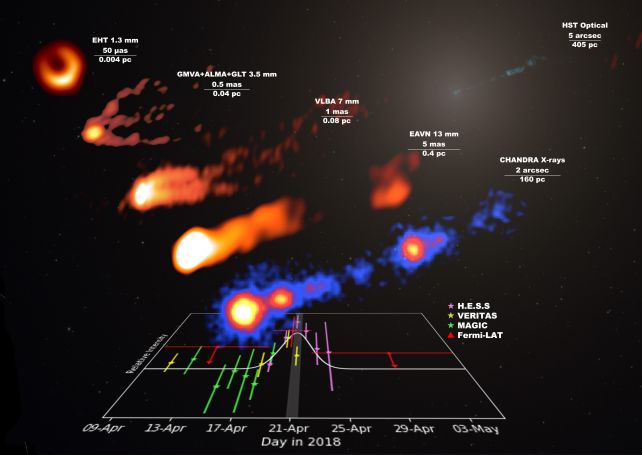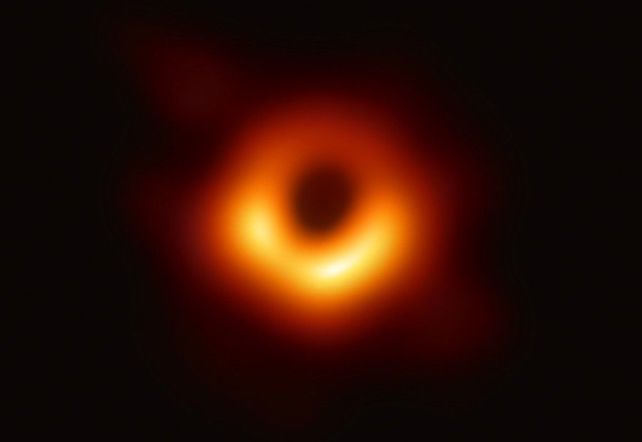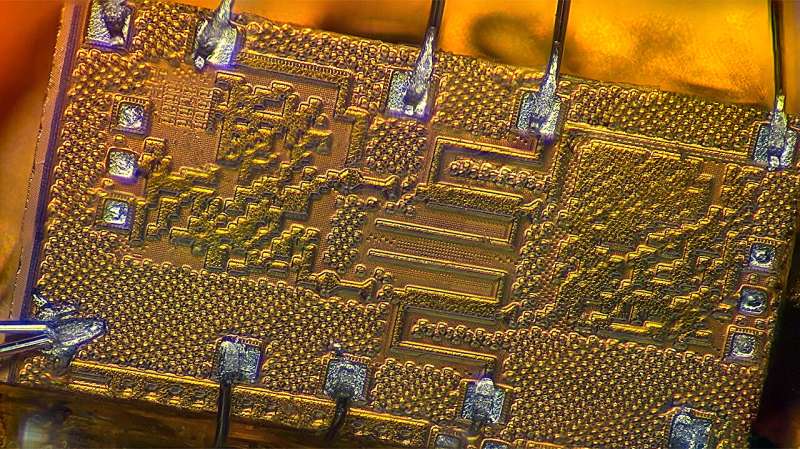When you stare for long enough into the heart of a galaxy to try to catch a glimpse of the black hole that lurks therein, that may not be all you catch.
When a huge collaboration directed telescopes around the world to the heart of galaxy M87 in 2018 in an ultimately successful effort to capture detail of its supermassive black hole, they also managed to observe some of the wild shenanigans such a black hole engages in.
Now, astronomers discovered that one of those shenanigans was a colossal belch – a gamma-ray eruption from one of the powerful jets of plasma launched from the black hole’s poles as it feeds.
“We were lucky to detect a gamma-ray flare from M87 during this Event Horizon Telescope’s multi-wavelength campaign,” says astrophysicist Giacomo Principe of the University of Trieste in Italy.
“This marks the first gamma-ray flaring event observed in this source in over a decade, allowing us to precisely constrain the size of the region responsible for the observed gamma-ray emission.”

M87, located just under 55 million light-years from the Milky Way, was chosen for humanity’s first image of the shadow of a supermassive black hole partially because its central black hole is actively slurping up material from a huge cloud of material around it.
The friction and gravity at play in the cloud of material heats it up and causes it to glow. That’s the source of the blobby light you see in the image of M87*. But a feeding supermassive black hole often exhibits another phenomenon, too: astrophysical jets.
Scientists think that these are generated by an interplay between the material and the black hole’s external magnetic field.
As material falls from the inner rim of the disk of gas and dust swirling around the black hole like water around a drain, some of it gets diverted along magnetic field lines outside the event horizon. It’s accelerated to the poles, where it is launched into space at tremendous speeds approaching that of light in a vacuum.
These are the astrophysical jets, and M87 has prominent ones. The black hole observations of the galaxy have been helping scientists understand this process better, with the most detailed observations ever obtained of the region from which the jets are launched.

As they stream away from the galaxy and into intergalactic space, the jets from a supermassive black hole can interact with objects they encounter, as well as generate some pretty wild turbulence.
The gamma-ray flares occasionally seen from these jets are thought to be the result of blobs of material that fall into the jet and are accelerated to extremely high energies, resulting in, well, flares of high-energy gamma-ray light.
As you might imagine, this makes them somewhat unpredictable. You can’t plan to observe one; you just have to hope that you are looking in the right place at the right time.
The flare serendipitously captured by the Event Horizon Telescope was a banger. It lasted for three days, a duration that corresponds with an emission region of less than 170 astronomical units – about 170 times the distance between Earth and the Sun.
“The rapid variability in gamma rays indicates that the flare region is extremely small, only approximately ten times the size of the central black hole,” explains astrophysicist Daniel Mazin of the University of Tokyo.
“Interestingly, the sharp variability observed in gamma rays was not detected in other wavelengths. This suggests that the flare region has a complex structure and exhibits different characteristics depending on the wavelength.”

Interestingly, the asymmetry of the blobby ring of light around the black hole changed in relation to the flare. The asymmetry presents as brighter and dimmer sections of the ring; when the flare was observed, these patches of relative brightness and dimness moved, suggesting a relationship between the ring and the flare.
The nature of the relationship is currently a mystery; the researchers were unable to pinpoint the source of the gamma-ray emission, or what caused it. But the observations give us new information that can help constrain future research efforts.
“How and where particles are accelerated in supermassive black hole jets is a longstanding mystery,” says theoretical astrophysicist Sera Markoff of the University of Amsterdam.
“For the first time, we can combine direct imaging of the near event horizon regions during gamma-ray flares from particle acceleration events and test theories about the flare origins.”
The research has been published in Astronomy & Astrophysics.








Leave a Comment